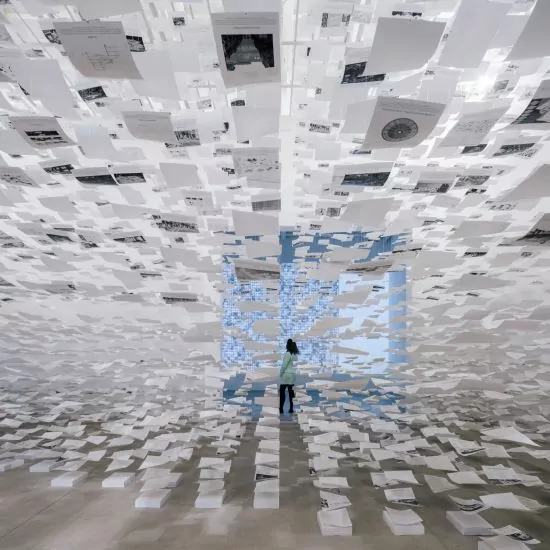So far, the curators of the Spanish Pavilion at the Venice Architecture Biennale have been chosen from among the most renowned artists - in recent years these have included Iñaqui Carnicero and Carlos Quintáns (2016) and Atxu Amann (2018). The 17th edition, whose motto is the question posed by Hashim Sarkis: "How will we live together?", it was decided to hold an open competition, in which nearly fifty teams participated. Among them were four young (born in 1988) architects from Tenerife - Andrzej Gwizdala, Domingo González, Fernando Herrera and Sofía Piñero. The motto of the pavilion selected for fall 2019 was "Uncertainty" ("Uncertainty"), which, according to Andrzej Gwizdala, one of the pavilion's curators, became the leitmotif of the past year.
Spanish Pavilion
Ola Kloc: The competition was decided in autumn 2019, the slogan you proposed turned out to be a prediction of what followed the whole world through the following months of the pandemic. How did these events affect your concept for the pavilion? Did it change over this year full of uncertainty? How did the design evolve from the idea you submitted to the competition to the shape you can now see in Venice?
Andrzej Gwizdała: It turned out that certain concepts, like insecurity or community, are universal, and I think that the pandemic did not create so many new problems, but rather highlighted existing ills, for which we rapidly began to look for cursory solutions. An example of this phenomenon is the housing problem. It's not that before the pandemic there was no shortage of housing, but now, when the authorities of a country say that we must stay at home and wash our hands, the question suddenly arises whether we really all have a home and access to water. As architects, we have already proposed solutions to many important issues, and if we had been able to implement them calmly, the social impact of the pandemic may have been less severe than as a result of the superficial solutions we had to implement on short notice during the lockdown. In the pavilion, for example, we present a design for a backpack that turns into a swing ["Swing Back Pack," pro: Araceli Calero Castro, Macarena Castillo Párraga, Rosa Gallardo Parralo]. Every time I look at it, I have images before my eyes of playgrounds sealed with tape, where no one could enter during the lockdown. It turned out that if children are not allowed to play in these strictly defined plazas, there is basically no place for them in public space, the city is closed to them.
"Swing Back Pack," pro: Araceli Calero Castro, Macarena Castillo Párraga, Rosa Gallardo Parralo
Ola: Why specifically Uncertainty?
AG: Beginning with an anecdote, in the previous edition of the biennial Atxu Amann 's "Becoming" pavilion staked her claim on the projects of a generation of Spanish architects who can no longer, like their predecessors, count on being immediately thrown into work and commissions as soon as they graduate. The space she proposed had more than fifty adjectives written out to define the architecture of the future. Two months after winning our competition, we discovered that the pavilion's last term was precisely uncertain, meaning uncertain. Only then did we feel that we were part of a certain continuity in the ideas of our more successful predecessors, that our design actually reflected a certain universal problem [laughter]. And in all seriousness, it is worth noting that for the first time in the history of the Biennale, the main theme was formulated as a question, and an open question at that. Hashim Sarkis decided to ask a very important, even timeless question, to which every generation has had to seek its own answers for centuries. We began to wonder whether in today's fast-changing reality we are capable of answering it, and whether we should do so at all.
We came to the conclusion that instead of giving an incisive answer, which would probably quickly lose its expiration date, it would be best if we took the stance of an architect coordinating a social dialogue. A dialogue based on a series of more specific questions that will expand and refine the main question so as to shift the privilege, or obligation, of answering to visitors. In view of this, in our approach to the topic, behind our decision not to explicitly answer the question through the theme of the pavilion, there is actually a vision of the architect as a social activist who asks the right questions, designs spaces for public debate and gives the public concrete tools so that they are able to reflect on their own future.
Ola: What kind of questions are these?
AG: After winning the first ever open call, we came to the conclusion that it would be most in line with our way of being to announce another open call for the entire community of architects from Spain and beyond. We wanted to give people a similar opportunity to the one we got ourselves, and we were met with an amazing response, as we ended up receiving as many as four hundred and sixty-six entries. We asked architects to submit projects that would go beyond the boundaries of what we commonly understand as architecture, look for inspiration in other disciplines and not focus on the finished object, but on the creative process. Their other key dimension was to be positive social impact. All projects combining both aspects were gathered in the central part of the pavilion - the "cloud of uncertainty."



"cloud of uncertainty"
Photo: Imagen Subliminal (Miguel de Guzman and Rocio Romero)







































